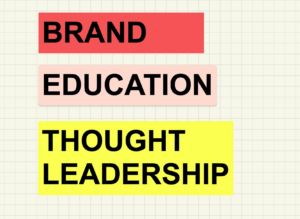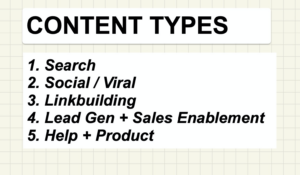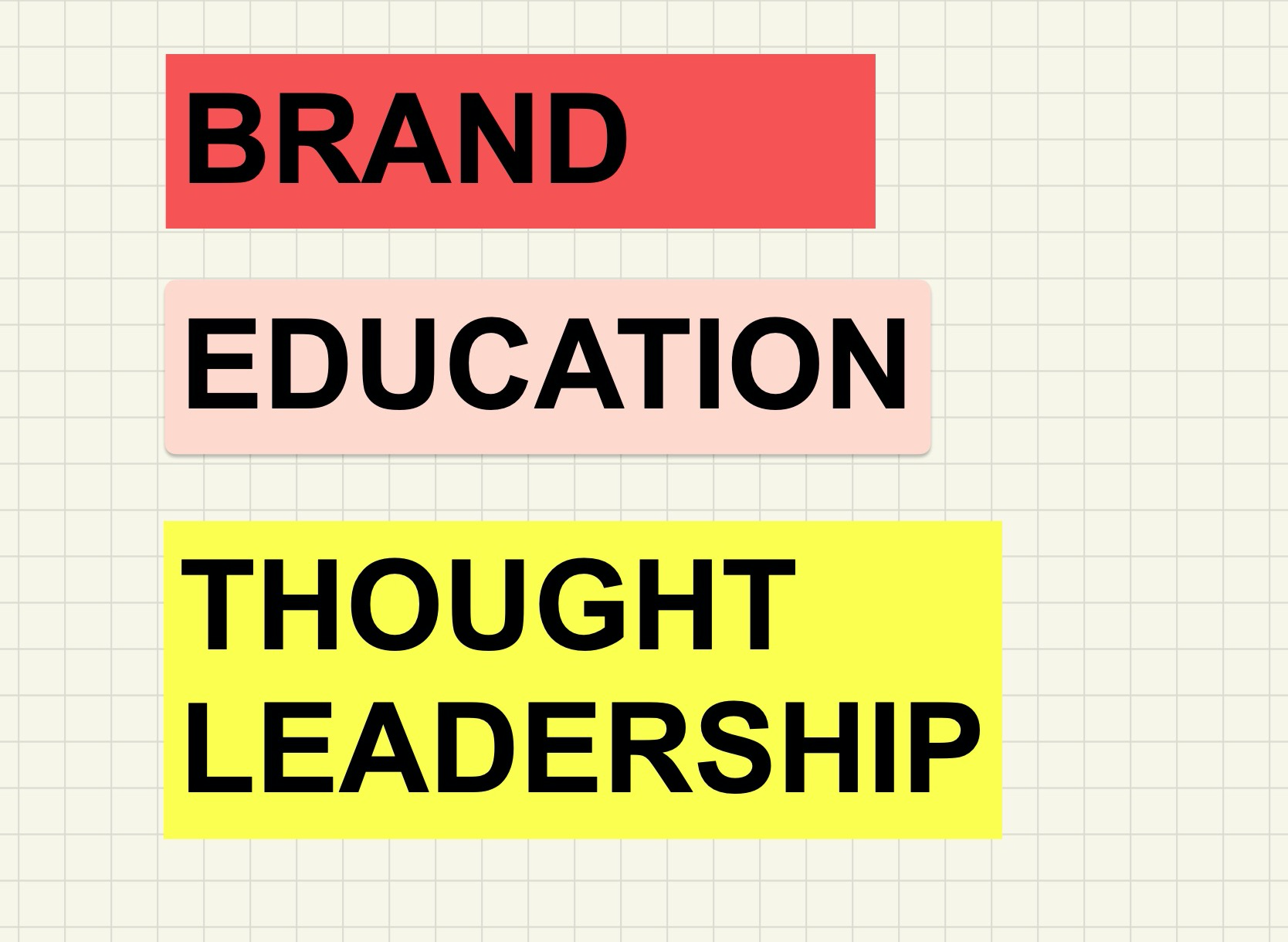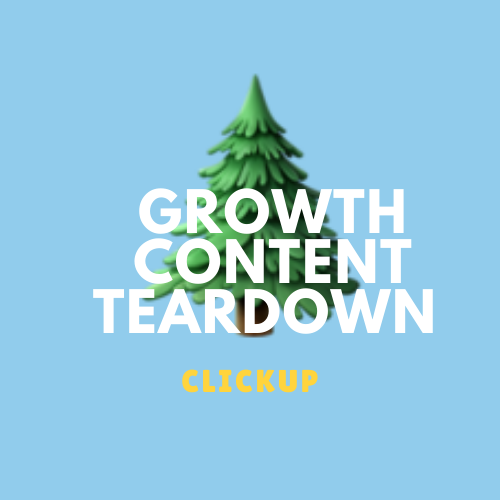3 Content Genres + 5 Content Types For B2B Marketing
Can you improve this article? Read it first (lol) and then leave me comments or messages about what other content types of example websites you would include. Contact me here.
If you’re frustrated with your content marketing efforts, it may be that you’re expecting too much out of each piece of content.
One piece of content (probably) won’t…
Get you all the leads…
AND become a viral sensation…
AND drive all of your search engine traffic…
AND gain thousands of links.
Before you start tweeting me with exceptions to the rule, I’ll just say those exceptions prove the rule.
Yes. It can happen.
But to aim for that (and to expect that!) every time is a set up for failure.
Instead, think about the genre of content that you’re producing and then adjust your expectations and channels to fit that piece. Don’t expect every post to do every job.
Confused? That’s what this post is for.
We’ll talk about the different genres of content in content marketing, the types of content that fit those genres, and then also the channels. You can figure this out, let’s go!
One Goal: Increase Revenue From Content
There are hundreds of ways to increase revenue; that’s way beyond the scope of a content marketing blog. However, we can think about content as a way to increase revenue.
Content marketing (as it is typically known) is to create organic content and have it appear in front of audiences, hopefully for free.
Content marketing initially took the form of written content but it has expanded to include podcasts, video, and photos.
However, there are still 3 main content genres for any B2B company to produce. I almost used the word “types” here but that will come along. I prefer “genres” because these content priorities can appear in many “types” or forms, and in many different channels.
3 Main Content Genres
- Brand / Product (Bottom Funnel)
- Thought Leadership (Top Funnel, Awareness)
- Education (Mid-Funnel)
These genres or categories were inspired by this post by Kieran Flanagan, who takes a slightly different spin on what I’m about to break down below.
Now, we’ll break down each of those priorities and what parts make up those content priorities.

1. Brand
Brand is the typical marketing function. It’s brand awareness. Think about a billboard with your company name on it, or a clever television commercial that makes your brand memorable. This is the traditional field of advertising. XYZ BRAND is the best [BLANK] for you.
• Geico is the best auto insurance company for you.
• Pepsi is the best soda for you.
• Domino’s is the best pizza for you.
This is completely reductive, and obviously there is lots more to advertising than just that.
But—brand in content marketing is a little bit different. Because at one time, brands had to depend on outside people to tell their stories (ads, articles, commercials), but now content marketing (something about the internet, yada yada yada) allows brands to have more control of their own narrative.
What makes up your brand story?
• Founder stories
• Mission statements
• Journeys to profitability
But it could also include more nuts & bolts things like:
• Product updates
• Why you have great customer service
• Plans and expansions
• Case studies
You’re creating stories about how you want your brand to be perceived, what it can do, and why you’re different.
In content marketing land, one of the most famous examples of this is the story of GrooveHQ. They are a customer support platform, but they found a lot of traction by sharing their brand story. And invited others to follow along on the ups and downs.
Takeaways
• People return to you because they “know” you and familiarity is built
• Works well for brands interested in storytelling and taking more time with content
• Great for truly disruptive products
• May not work for non-branded SEO searches
Examples:
Best Channels For This:
• Organic social
• Paid social
• In-app product messaging / live chat
• Conversion-focused landing pages
2. Thought Leadership / Industry Commentary
Another approach to content creation is to invest in thought leadership and industry commentary from your top execs or by hosting guest posts from other thought leaders on your blog.
I call this brand adjacent content.
The low-effort way to do this are those expert round-ups.
The high-end way to do this is by nice, intelligent conversations (see First Round Review)
PR work is the most traditional form of this.
You hope to get a quote or mention in a story because then your brand gets a shout. You’ll get a few extra website hits with increased brand awareness.
What’s nice is that you can do this both ways now—internally and externally. You can post on your site (internal), but then also guest post on others, or offer an expert quote.
Your blog can only be about riffing on the industry news or trends, and not necessarily guided by search queries. You could build up a following because of your great commentary and become a trusted resource, that oh yeah, happens to sell this thing over here.
The channel killing this right now is podcasts. If you think about it, they are the perfect mix of brand-adjacent thought leadership and industry commentary going into the market.
People discussing ideas.
People responding to ideas.
Written content can do it (think Q&As and oral histories) but right now the world is on fire with podcasts.
Being on a podcast is the same as doing a guest blog post 7 years ago.
You’re capturing someone else’s authority, audience, and hopefully high domain rating to link back to your site.
Just to be clear, this genre (thought leadership/industry commentary) can be in many channels but podcasts are a top channel for it right now.
Another emerging channel for this: community networks. Everyone on my LinkedIn feed is asking about how do you form a community of {BLANK}. This occurs around a product or service within a certain industry. This really took off on forums, then Facebook Groups, and is now moving to Slack channels plus paid membership platforms. This is of course has a network effect, but is also promoting the genre of thought leadership and industry commentary.
Takeaways:
• People value and respect your take, then they will (hopefully) check out your brand
• Thoughtful, ongoing commentary can make you into a trusted source
• Including others helps strengthens community networks and forms ties by association to your product and brand
Examples:
- First Round Review
- How I Built This
- Any company podcast
Best Channels For This:
• Interview blogs
• Expert quotes
• Organic social
• Newsletters
• Podcasts/video interviews
• Membership groups and Slack Channels
3. Education
Evergreen how-to and tactical content will mainly fall into this bucket. It answers a specific problem or offers insights on topics that users are searching for.
This is the most well-known form of content marketing that has addressed different parts of the traditional funnel: problem aware (Top), solution aware (Mid), and product aware (Bottom).
Branded content or thought leadership content is considered more “attractional” content that is great for bringing in links and social shares. How-to evergreen content does not usually lend itself to viral and social shares, but answers specific queries.
Keyword research is a very important component of this content genre to match what your product does to what people are searching for. This is sometimes very obvious, other times it isn’t.
That’s why keyword research plays such an important role in creating educational content, in addition to regularly speaking with your core customers and ideal customers about their pain points.
As a genre though, education content doesn’t have to be based on keyword research. Search content is a type of content, best fitted to educational content (more on that below). However, the two are different.
It could be explaining exactly what you do, the benefits, and how it helps solve customer frustrations.
Those elements plus keyword research helps it take off.
Takeaways
• Answers specific user queries
• Much of the content is traditionally based on keyword research and different parts of the buying funnel
• Other sources for educational content includes user queries, customer success calls, sales calls, and social media searches
Examples
Best Channels For This:
• Company website
• Forums / Q&A sites (like Quora or Reddit)
5 Content Types For Your Content Marketing
Before I dive into each of these, let’s recognize one thing — lots of blog posts could be written (and have been written) about each of these content pieces. Each one of these deserves its own strategy and plan. This is a high-level overview. For more on the different types of content frameworks, I highly suggest this post at Optimist.
Each of the content genres also best match certain channels. The message fits the medium.

1. Search Content
Create informative content on chosen topics for SEO. These are driven by highly-searched, high buying intent keywords. You’re trying to answer questions for users that match your ideal profile and interest. Most often, this takes the form of written content or videos.
Genre: Educaton
What works: Keyword-driven articles & research plus answering “what is” or “how-to” questions about a product or service, videos for search
2. Social/Viral Content
This content will earn shares and likes to drive traffic from a broad audience. Many people aim for this, but it’s hard to achieve on a regular basis. It’s also the hardest content to plan for. Content that does well on Facebook, Twitter, LinkedIn, Instagram, TikTok or wherever that won’t necessarily be optimized for search. These pieces focus on gaining attention and drive curiosity. Your thought leadership
Genre: Brand and thought leadership
What works: Memes, interesting quotes, celebrity profiles, site teardowns, interesting facts, videos
3. Linkbuilding Content
With linkbuilding content, you’re trying to improve the credibility of your site. The more links you have to your article or website, the more important Google will think your site is. Linkbuilding content will help your other content eventually, you just need a boost.
Link building is that boost. Reach out to influencers — reporters and others blogs — to gain links for credibility. This is content that peers, writers, editors, and even competitors will find interesting.
In reality, all genres can work for this, though thought leadership in general is better for linkbuilding. If you include interesting stats and data points even within your educational content, that will help.
Genre: Brand, thought leadership, education
What works: Statistics, interesting points of views, podcasts, sky-scraper content, compilations
4. Lead Gen Content + Sales Enablement
Create sales-based content and collateral to use during the sales process. This content is also great as pillar content (guides, presentations, webinars) to drive awareness and to be a definitive expert on a subject. It could also include sales sheets, brochures, or other collateral that educates and emphasizes your brand. Some of these pieces will be educational or brand enhancement.
These posts is also where your conversion landing pages would fall, too.
Genre: Education, brand
What works: Experts, answering specific questions about benefits, problem-solving tactics, content at the bottom of the buying funnel, conversion-focused pages
5. Help + Product Content
These are 2 HUGGGGEEE areas of content, that grow importance especially as your brand grows, or if you have a complex product.
A national retailer for instance has lots and lots of product pages optimized for search. In the same way, a massive software tool like Salesforce or Microsoft also has loads of searchable help content.
In the B2B SaaS world, Investing in this type of content can take a burden off your customer success teams as your build your knowledge base of how-to’s. I don’t generally consider this as part of the traditional content marketing funnel. Usually, content marketing is trying to solve larger problems than how to open a file or to run a certain function within a product. But it depends on the type of product you have or what you’re trying to sell. Obviously, there are big media sites that create tutorials on popular SaaS products (think about a tutorial on Google Sheets) that definitely fall within the content marketing bucket.
Genre: Education
What works: Product tutorials, product videos, how-to videos, specific checklists and steps, product details and information
Conclusion: What’s the Right Content Marketing Mix?
Ultimately, a site would like to have a combination of all of these types of content and genres. Companies are becoming more like media companies everyday, and many companies can pull all of these off in a variety of channels (something this post didn’t address as much).
I usually suggest to companies that are starting off to have 2-3 channels they are invested (that includes Google search). That could be 2 social channels, or 2 different paid media formats.
Bottom line: Adjust your expectations for your content. Don’t expect one piece of content to be the best at conversions and linkbuilding and search.
Can you improve this article? Leave me comments or notes about what other content types of example websites you would include.


